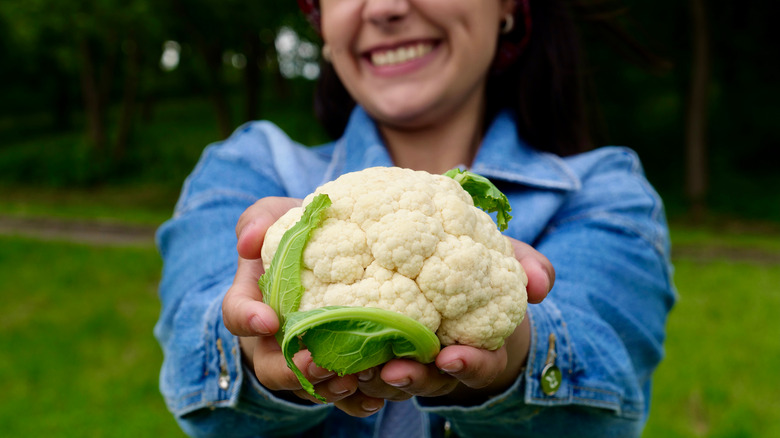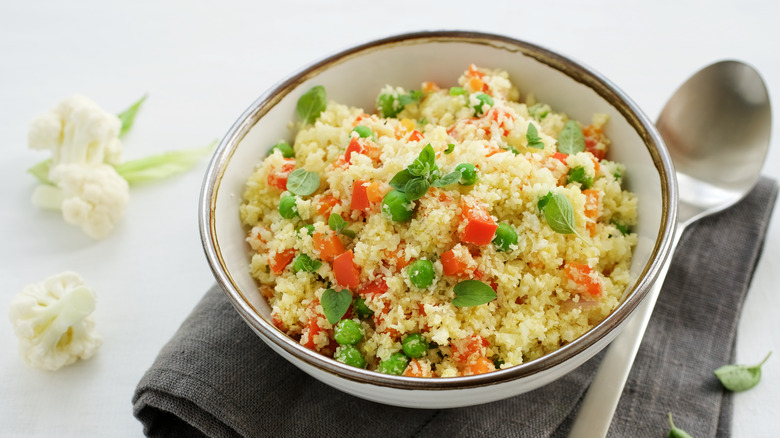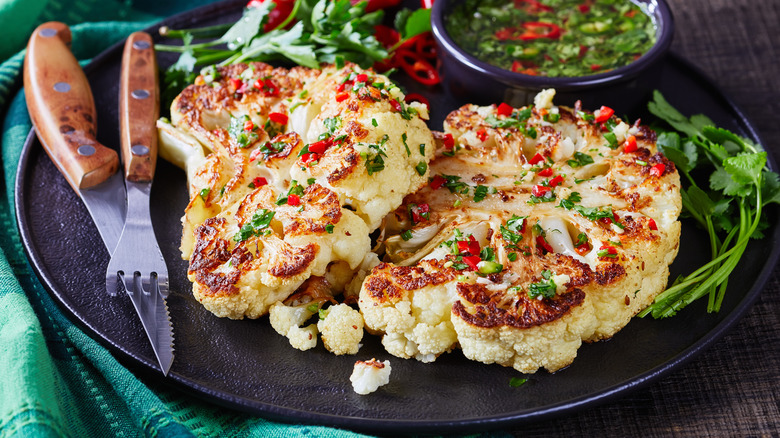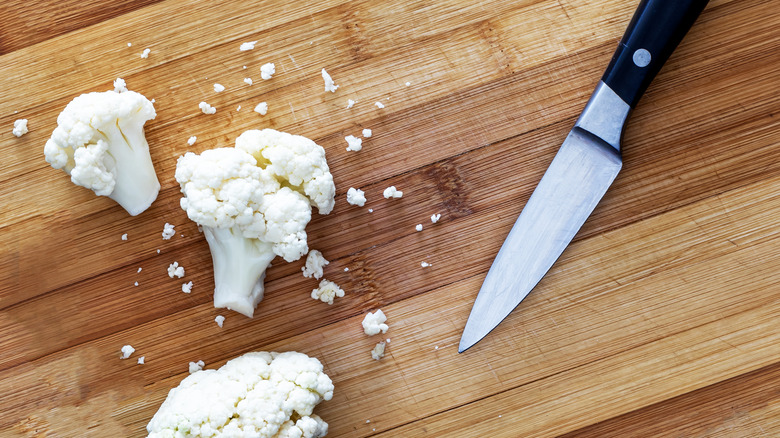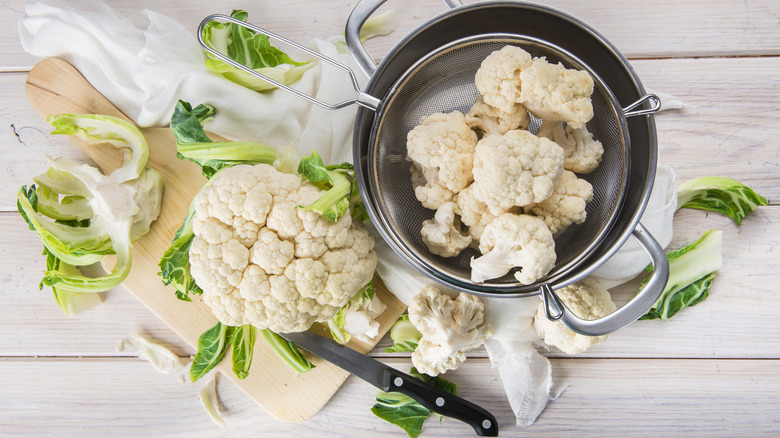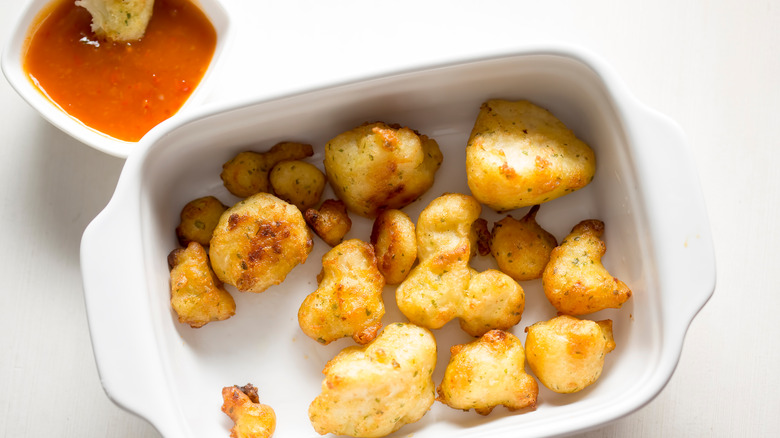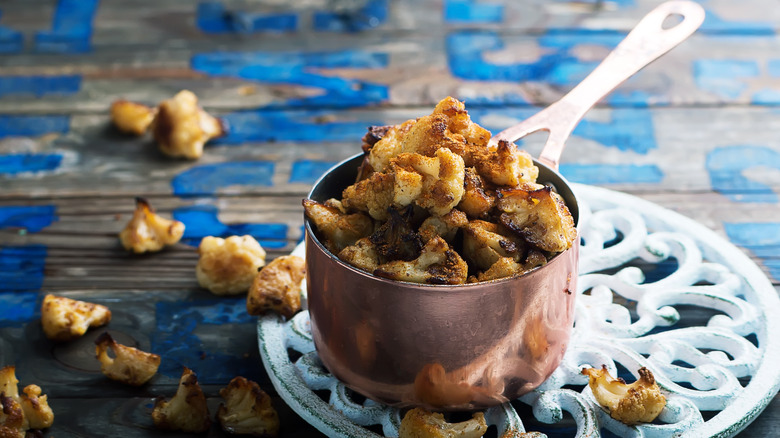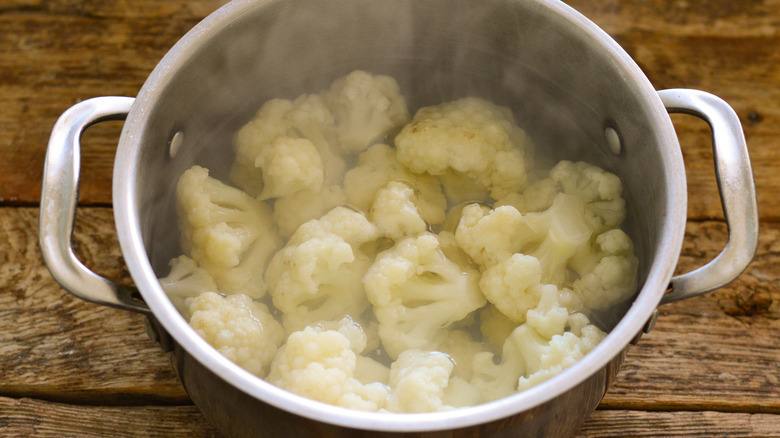10 Cauliflower Hacks You Need To Know
You may remember eating cauliflower with a sense of dread (or trying to avoid it) as a child. Soft and watery, there was nothing to love about the insipid-looking, limp florets served as an afterthought or hidden under a sauce. Fast-forward to the present, and cauliflower has gone through a foodie transformation, becoming a star attraction and courting incredible recipes. It's not just fresh cauliflower that is in demand either, and the vegetable is used to make products including pizza crusts, tortillas, and pasta (via USDA). Meanwhile, according to 2019 data by IndexBox, the US was the third biggest consumer of cauliflower behind China and India.
In short, cauliflower is quite possibly one of the most on-trend vegetables, and with the rise of plant-based diets and campaigns such as Meat Free Mondays, it has come into its own as one of the most marvelous cruciferous vegetables. Cauliflower found its way into the spotlight around the same time as low-carb vegetable-forward diets became more prevalent according to Suzy Badaracco, president of Culinary Tides, trend forecasters of the food industry (via Vox). Badaracco adds that it was an easy alternative for meat and carb-based dishes "because it kind of fit everything."
However, while memories of soggy cauliflower fade with time, you may still not be sure how to pick, store, and prepare your cauliflower for top results. Read on for our list of cauliflower hacks you need to know.
1. Roast cauliflower to make rice
If you're trying to follow a low-carb or no-carb diet such as paleo, keto, or Atkins, then cauliflower rice is a great alternative. It's so good that unlike some mediocre replacements, you might actually find yourself reaching for cauliflower instead of a bag of grains. All good and well, but while cauliflower bits can be used in place of rice, do you cook them the same way? First off, you've got to turn your cauliflower into rice. You can buy cauliflower rice, of course, but it's easy to make yourself by grating or breaking it up in a food processor (via Minimalist Baker).
Among the many options, you can boil or steam cauliflower rice, and you can also fry it for risotto or to make egg-fried rice. Alternatively, per Well + Good, Reddit user jasmine_tea_w_honey suggests roasting the cauliflower rice to cook it. First of all, squeeze out any moisture from the grated cauliflower to prevent the rice from being soggy. Next, transfer the rice to a baking tray, drizzle on some olive oil, and roast it in the oven at 400 degrees until the color changes and the grains become golden and soft.
2. Make cauliflower steaks
If you've never tried a cauliflower steak, there's only really one piece of advice: Try it! Roasted cauliflower is so delicious that tasting it for the first time is akin to discovering a new food secret. Who knew that vegetables could taste this good? Cauliflower is far more than a supporting side dish, and a cauliflower steak, roasted in the oven or grilled, is a showstopper on its own.
The trick to great cauliflower steaks is all about cutting it properly. First, you need a sharp knife and a large cauliflower if you want more than a couple of steaks. Lay the vegetable on a cutting board on its side with the stalk facing you. Then, cut down so that the cauliflower is, in effect, sliced vertically. Florets will break away, and you can use these for another dish. The steaks are the slices that have the core still attached since they will stay intact. For a guaranteed caramelized flavor, meaty texture, and to avoid over or undercooking it, a thickness of around 1.5 inches is ideal (via Real Simple).
First, season the cauliflower with salt and olive oil, and any other spices you like. Then, cover the steaks with foil and roast them for 10 minutes at 400 degrees, before uncovering and browning them for another five minutes at 450 degrees. Once done, you should be able to easily poke a fork into the steak.
3. Learn Barefoot Contessa's clever cutting trick
If you've ever cut cauliflower only to find that little bits of it seem to scatter just about everywhere, then it could be that you're not cutting it correctly. A simple yet effective cauliflower hack was demonstrated by Ina Garten, aka Barefoot Contessa. The beauty is that it takes no more time than any other method, and it's definitely quicker to clean up afterward.
Garten demonstrates every step in a video on Facebook to make it easy to follow along. First, she turns the cauliflower upside down and uses a knife to cut around the stalk, causing large pieces of cauliflower to fall away. Next, she cuts into each of these individual pieces, pulling the florets apart with her hands. Meanwhile, viewers will notice that her chopping board is free from tiny cauliflower crumbs. Once you try Garten's easy mess-free trick, you'll undoubtedly never cut cauliflower any other way again.
4. Cut a cauliflower without a knife
If you ever find yourself with cauliflower to prepare and no knife on hand, (or perhaps you're so busy that you don't have time to reach into the kitchen drawer to get one), we've got a solution. TikTok user @rachelcooksblog demonstrates a trick to break up a whole cauliflower into florets, without a knife or chopping board. Plus, it also looks like a good way to channel some of your energy (or angst).
Keep in mind that this trick works best with a plastic-wrapped cauliflower. Hold it in both hands with the head pointing down and the stalk facing up, then smash it straight down onto a kitchen counter. Repeat this a few times before flipping the cauliflower over and cutting the wrap open. You'll be left with pieces of cauliflower, and the banging won't even bruise the vegetable's surface. Remove the main stalk and green leaves, break up any large pieces by hand, and transfer the whole lot straight into a colander to be rinsed.
5. Make Buffalo cauliflower bites
It may feel as if Buffalo wings – one of the most iconic bar snacks — have been around forever. However, the deep-fried spicy chicken wings from Buffalo, New York were first created in the 1960s and initially only eaten close to home (via Time). As much as this crispy treat is loved by many, it's only fair to create a vegetarian alternative. There are lots of different ways to make this crunchy yet soft-in-the-middle snack, and you can choose from various Buffalo cauliflower recipes to find the one that appeals to you.
TikTok food blogger @faithsfresh posted a video that has amassed over 4.6 million views, where she makes cauliflower wings in an air-fryer instead of deep-frying them. She starts by making a vegan batter with almond milk, flour, onion powder, and garlic powder. Once the cauliflower is coated, she transfers it to an air-fryer for 14 minutes. The crunchy-looking morsels are then dipped in hot sauce and cooked for another six minutes, before being served with a creamy dip.
6. Keep colorful cauliflower colorful
If you've only come across white cauliflower, then you're missing out on some pretty colorful variations. Take the vibrantly hued purple cauliflower, which has all the goodies found in white cauliflower, but with an antioxidant that is also found in red wine (via Modern Farmer). Meanwhile, green cauliflower contains chlorophyll and orange cauliflower contains beta-carotene. There's also the greenish-yellow spiky Roman cauliflower which Allrecipes explains is in fact a hybrid between broccoli and cauliflower.
If you want to prevent any of the dramatic colors from fading away, pay close attention to how you cook them. Orange cauliflowers are fairly robust, and you can cook them for a long time without losing color. This variety may be a good choice if you are making a dish that requires a lot of cooking. Meanwhile, purple cauliflowers are a lot more sensitive, so don't boil or steam them for long. Alternatively, sauté them to retain the bright colors. Finally, if you're making a dish with green cauliflower, don't overcook it when boiling or steaming or else the chlorophyll will start to brown (via Cooks Illustrated).
7. Stop white cauliflower from turning yellow
There's something so beautiful about a whiter-than-white cauliflower, and it definitely looks less appetizing when it starts to change color. Smarty Pants Kitchen explains that cauliflower stays white when its environment is acidic. Cooking can reduce acidity and allow oxygen to get into contact with the vegetable, causing it to brown. If you're serving up cooked cauliflower or want to add a few florets to a plate of crudites, then how do you keep it looking white?
A few tips can be combined for maximum success. For starters, make sure the knife you use to cut the cauliflower is stainless steel, which won't react and cause a change in acidity levels. When cooking cauliflower, avoid non-stick and aluminum pans as these lead to discoloration. It's also best to keep cauliflower covered before use and wrap it with a damp paper towel to maintain its freshness and color (via Elpasony.com). By keeping your cauliflower perfectly white, you can fool anyone by serving cauliflower mash instead of mashed potatoes.
8. Make crunchy layers for popcorn cauliflower
Traditionally a food from the South, popcorn chicken has been around for centuries (via Taste Atlas). Yet again, this bite-sized dish isn't suitable for vegetarians, but that's no reason for anyone to miss out on the flavor! An exciting variation and delicious plant-based alternative is popcorn cauliflower.
To achieve a creamy soft interior and crispy exterior, Nish Kitchen recommends creating a double layer of crunch. Once you've cooked the florets for five minutes in boiling water, dip them in a batter made with flour, cornstarch, water, yogurt, and your choice of spices and seasoning. Then, coat them with breadcrumbs; for an extra crunchy texture, use Japanese-style panko breadcrumbs which are lighter and flakier, producing a crispier result, according to Allrecipes. Once you've deep-fried the coated bites until they're a rich golden color, your popcorn cauliflower is ready. Serve it with dip and let the snacking begin!
9. Try roasting cauliflower popcorn instead
If you're on board with cauliflower popcorn but want to skip the deep-frying, excellent versions are made by roasting the florets. Chowhound explains that roasting cauliflower and other vegetables helps enhance their sweetness. This is because the heat breaks down the natural sugars in the vegetables and sets off a caramelization process, ultimately creating a rich flavor with nuttiness and plenty of complexity and depth.
To get the most out of the taste, cauliflower florets can be tossed in oil with salt and maple syrup before you pop them into the oven at 425 degrees, per Eating Bird Food. Or, pick your favorite popcorn seasoning and properly coat the florets before roasting them. A good tip when roasting is to avoid crowding the pieces of cauliflower popcorn so that they can crunch up in the heat instead of being steamed. This might become your new favorite snack!
10. Avoid using water to cook
Author of Brassicas: Cooking the World's Healthiest Vegetables, Laura Russell is somewhat of an expert on cauliflowers. In a feature in Men's Journal, she first explains how to shop for a good quality cauliflower, before giving her opinion about how to cook it. Her golden rule is not to let cauliflower touch water or else it quickly becomes overcooked. Plus, it also creates that distinct cauliflower odor that lingers, bringing up memories of school canteen lunches.
Following her tips, once you've found a lovely cauliflower, give the whole vegetable a quick rinse, ensuring not to drench individual florets. Next, roast, sauté, or steam your cauliflower, and don't even think about boiling it or putting it in the microwave which will also bring out an unpleasant scent. Water is not cauliflower's friend! Using any other method, be sure to season the cauliflower as it cooks, building delicious flavors to complement your meal.
